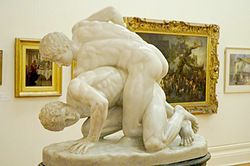Vasari Corridor

The Vasari Corridor (Italian: Corridoio Vasariano) is an elevated enclosed passageway in Florence, central Italy, connecting the Palazzo Vecchio with the Palazzo Pitti. Beginning on the south side of the Palazzo Vecchio, it joins the Uffizi Gallery and leaves on its south side, crossing the Lungarno dei Archibusieri, then following the north bank of the River Arno until it crosses the river at Ponte Vecchio. At the time of construction, the corridor had to be built around the Torre dei Mannelli, using brackets, because the tower's owners refused to alter it. The corridor conceals part of the façade of the Church of Santa Felicità. It then snakes its way over rows of houses in the Oltrarno district, becoming narrower, to finally join the Palazzo Pitti. The corridor's full length is approximately one kilometre.In 2016, the corridor was closed for safety reasons and was set to re-open for tourists on 27 May 2022, marking the anniversary of the 1993 Via dei Georgofili bombing, after an 11-month renovation.
Excerpt from the Wikipedia article Vasari Corridor (License: CC BY-SA 3.0, Authors, Images).Vasari Corridor
Lungarno degli Archibusieri, Florence Quartiere 1
Geographical coordinates (GPS) Address Nearby Places Show on map
Geographical coordinates (GPS)
| Latitude | Longitude |
|---|---|
| N 43.768202777778 ° | E 11.254047222222 ° |
Address
Corridoio Vasariano
Lungarno degli Archibusieri
50125 Florence, Quartiere 1
Tuscany, Italy
Open on Google Maps











